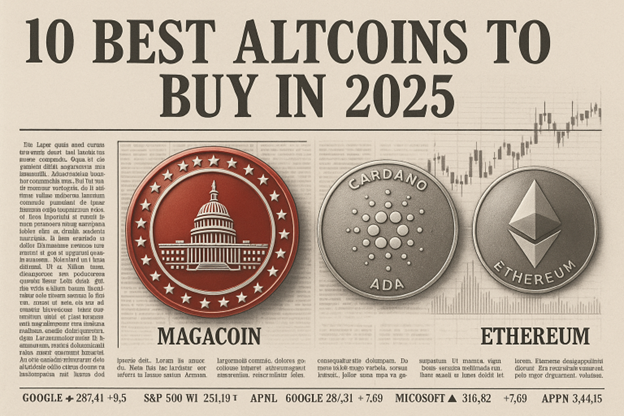10 Best Altcoins to Buy in 2025 — MAGACOIN, Cardano and Ethereum Highlighted by Analysts

Crypto investors are already gearing up for 2025, scanning the market for the best altcoins to hold before the next bull run. Some projects are gaining real traction with strong forecasts and active communities. Analysts say a handful of tokens could lead the charge next year, and MAGACOIN FINANCE is one of them. Alongside Ethereum and Cardano, it’s being highlighted as a top pick for strong growth potential.
MAGACOIN FINANCE—Analysts See Up to 30x Returns Fueling FOMO in 2025
MAGACOIN FINANCE is topping the list of altcoins to watch right now. Backed by strong investor confidence, its buzz has spread quickly across trading circles. Analysts are calling it the best altcoin to buy today, and forecasts even suggest it could deliver up to 30x gains. Such potential is what is getting the attention of retail buyers, as well as seasoned traders who do not want to miss out before the market heats up. As crypto sentiment improves and hype around the next bull run gets closer, MAGA has positioned itself as the token that could surprise everyone in 2025.
Cardano (ADA)
Cardano is a mature proof-of-stake Layer-1 blockchain. Its emphasis on scalability, security, and sustainability offers something attractive to investors interested in long-term stability. Future plans such as the Hydra and Basho upgrades will enhance throughput and interoperability to keep ADA on a stable growth trajectory. Analysts expect its price to be between $1.50 and $3 at the end of 2025. The possibility of an ETF approval means new funding entering the ecosystem, and the developer ecosystem and partnerships with the real world maintain bullish momentum among investors.
Ethereum (ETH)
Ethereum is still the foundation of decentralized finance and Web3 applications. ETH has maintained its hold on the market because of staking, liquidity pools, and their extensive adoption in NFTs. Analysts forecast that ETH will be valued between $3,000 and $5,000 in 2025. Its transition to proof-of-stake has reduced energy consumption and improved its efficiency, and future updates target scalability and lower gas fees. Institutional demand, supported by ETFs and futures, should also fuel momentum for Ethereum through the year.
Avalanche (AVAX)
Avalanche is expected to trade in the $18.70 to $74.60 range in 2025, with some forecasts eyeing even higher prices. Quarterly token burns are reducing supply, giving AVAX a tightening effect as demand rises. Fast transactions and low fees position it well for DeFi and NFT growth. Partnerships and growing adoption of real-world asset solutions add fuel to the outlook.
Binance Coin (BNB)
BNB supports the Binance ecosystem and remains a staple for trading fees, staking, and DeFi platforms. Analysts are projecting between $600 and $1,000 later in 2025 due to token burns driving it higher. BNB is one of the more stable options in the long run due to its increasing user base and product development.
Polygon (POL)
The fact that Polygon acts as an Ethereum scaling agent makes it sustainable. The migration of the POL tokens enhances security and staking abilities. Analysts are predicting a price range of between $1.50 and $3.50 by 2025. Alliances with businesses and governments also increase adoption.
Aave (AAVE)
Aave remains a prominent DeFi protocol that provides borrowing and lending services. Analysts believe it will cost between $70 and $150 by 2025. The combination of robust governance and liquidity incentives favors a positive trajectory. It attracts investors who are seeking reliable exposure to decentralized finance without exceptionally high volatility.
TRON (TRX)
TRON is a safe cryptocurrency, and many experts think that by the end of the year, this token could be worth between $0.10 and $0.30. It can be used for NFTs and games because it has low fees and operates fast.
Chainlink (LINK)
For smart contracts to work, Chainlink’s autonomous oracle network is very important. The price of LINK is expected to reach between $15 and $50 next year, according to analysts. LINK remains in the spotlight as more people adopt DeFi, gaming, and enterprise applications. It will be worth more in the long run with upgrades like cross-blockchain oracles.
Solana (SOL)
Solana is still a popular choice for builders and banks. According to predictions, it might be worth between $80 and $200 in 2025, with the average target being $150. Many games, NFTs, and scalable banking apps like it because it is fast and has low fees. Investor demand is still strong, even though network breakdowns are still a risk.
Final Thoughts
The crypto space in 2025 is looking like a goldmine, with only a few tokens gaining real momentum: Ethereum and Cardano are reliable choices with extensive ecosystems whereas Solana, Polygon and others can grow to be highly popular. Still, many analysts keep circling back to MAGACOIN FINANCE—its community backing and forecasted 30x upside make it the standout altcoin worth watching as the next bull run gets closer.
To learn more about MAGACOIN FINANCE, visit:
Website: https://magacoinfinance.com
Access: https://magacoinfinance.com/access
Twitter/X: https://x.com/magacoinfinance
Telegram: https://t.me/magacoinfinance
Disclaimer: This is a Press Release provided by a third party who is responsible for the content. Please conduct your own research before taking any action based on the content.
Editor-in-Chief of Blockonomi and founder of Kooc Media, A UK-Based Online Media Company. Believer in Open-Source Software, Blockchain Technology & a Free and Fair Internet for all.
His writing has been quoted by Nasdaq, Dow Jones, Investopedia, The New Yorker, Forbes, Techcrunch & More. Contact [email protected]






